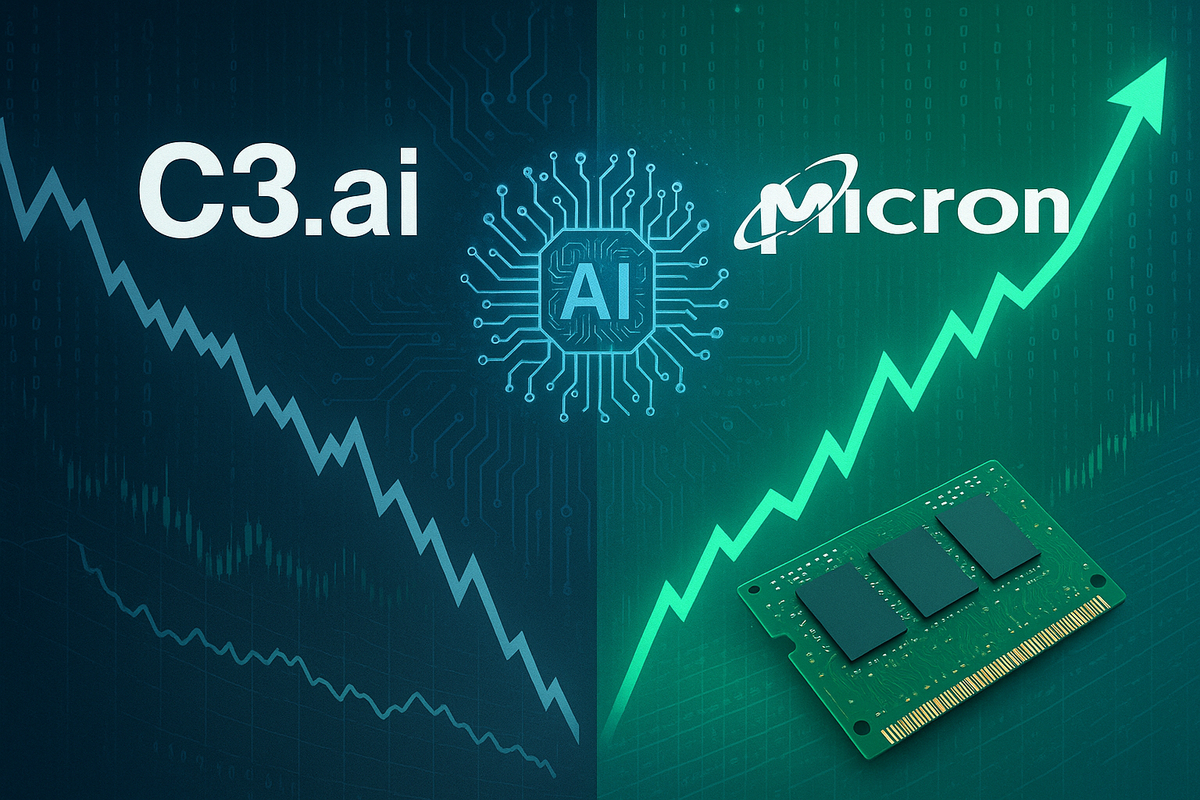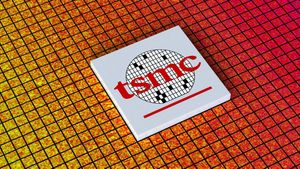
The financial markets are currently witnessing a stark divergence in corporate fortunes, highlighted by the recent earnings reports of two prominent technology companies. C3.ai (NYSE: AI), an enterprise AI software provider, has experienced a significant stock tumble following a warning of a potential operating loss and a critical assessment of its sales performance by its CEO. In stark contrast, memory chip giant Micron Technology (NASDAQ: MU) saw its stock climb after raising its profit and revenue forecasts, benefiting from surging demand and higher product prices, particularly in the burgeoning artificial intelligence sector. This juxtaposition underscores the volatile nature of the tech market, where innovation and market demand dictate immediate investor sentiment and long-term prospects.
What Happened and Why It Matters
C3.ai (NYSE: AI) recently delivered preliminary financial results for its first quarter of fiscal year 2026 that sent shockwaves through the market, causing its stock to plunge by approximately 30-32% in pre-market trading. The company anticipates total revenue for the quarter to be between $70.2 million and $70.4 million, a significant miss compared to its prior guidance of $100 million to $109 million, representing a 33% shortfall at the midpoint and a 19% year-over-year decline. Compounding the revenue woes, C3.ai expects a GAAP operating loss between $124.7 million and $124.9 million, with the non-GAAP adjusted operating loss projected to be roughly double its earlier forecast.
The primary drivers behind this disappointing performance, as articulated by CEO Tom Siebel, include a major reorganization of the global sales and service teams, which caused short-term disruption. Siebel also cited his personal health issues, specifically an autoimmune disease leading to severe vision loss, which limited his active participation in the sales process during the quarter. Adding to investor uncertainty, Siebel announced his intention to step down as CEO due to health reasons, with a search for a new leader underway. Analysts have also pointed to concerns over C3.ai's increasing reliance on non-recurring revenue, with nearly 50% of the previous quarter's revenue stemming from one-time License and Professional Engineering Services, suggesting a volatile revenue stream. This confluence of factors led to immediate analyst downgrades and a significant erosion of investor confidence, highlighting the critical importance of consistent execution and clear leadership in the enterprise software space.
Corporate Fortunes: Winners and Losers
While C3.ai grappled with internal challenges and a sales slump, Micron Technology (NASDAQ: MU) emerged as a clear winner in the recent earnings cycle, demonstrating the robust demand for memory chips, particularly those powering artificial intelligence. Micron significantly revised its fourth-quarter fiscal 2025 financial guidance upwards, now expecting revenue to be approximately $11.2 billion, an increase from its previous forecast of $10.7 billion. The adjusted earnings per share (EPS) forecast also saw a substantial boost to $2.85, up from an earlier projection of $2.50.
Micron's optimistic outlook is primarily attributed to improved market conditions for memory chips, especially in the dynamic random-access memory (DRAM) segment, and surging demand fueled by AI infrastructure. The company highlighted better pricing and strong operational execution as key contributors. A major catalyst for Micron's growth is the escalating demand for its high-bandwidth memory (HBM) chips, which are crucial for AI computing and closely integrated with NVIDIA (NASDAQ: NVDA) processors. The complexity of HBM production has kept supply tight, driving up prices and positioning Micron as a key enabler of the AI boom. This strong performance and positive market reaction, with shares climbing significantly, underscore Micron's strategic advantage in a recovering memory market and its pivotal role in the AI revolution.
Industry Impact and Broader Implications
The contrasting fortunes of C3.ai and Micron Technology offer a microcosm of the broader trends shaping the technology industry. Micron's surge is a testament to the insatiable demand for computational power driven by the artificial intelligence revolution. The rapid expansion of AI data centers and the increasing sophistication of AI models necessitate high-performance memory solutions like HBM, creating a robust market for companies like Micron. This trend suggests a continued boom for semiconductor manufacturers and memory providers, as AI infrastructure build-out remains a top priority for tech giants. The recovery in the broader memory market, coupled with emerging applications in AI, data centers, and edge computing, is materializing faster than many anticipated, signaling a strong cycle for the semiconductor industry.
Conversely, C3.ai's struggles highlight the inherent challenges in the enterprise AI software sector. While the promise of AI is immense, the path to widespread adoption and consistent revenue generation for specialized AI software companies can be fraught with difficulties. Sales execution, leadership stability, and the ability to deliver tangible, recurring value to customers are paramount. C3.ai's reliance on non-recurring revenue and internal organizational disruptions underscore the need for robust business models and operational efficiency, even for companies at the forefront of cutting-edge technology. This event serves as a cautionary tale that even in a booming sector like AI, fundamental business principles and execution remain critical for sustained success and investor confidence.
What Comes Next
For C3.ai, the immediate future involves a critical period of transition and strategic recalibration. The company anticipates a potential recovery in the second quarter, with guidance suggesting revenue between $95.5 million and $100.5 million. However, the path to achieving free cash flow breakeven in Q4 2025 remains uncertain. The search for a new CEO will be paramount, as a strong leader is needed to stabilize operations, regain investor trust, and steer the company through its sales reorganization. C3.ai will need to demonstrate consistent execution, potentially by developing more turnkey, cross-industry applications, to reduce reliance on one-time services and establish more predictable revenue streams. Investors will be closely watching for signs of improved sales performance and a clear strategic direction under new leadership.
Micron Technology, on the other hand, appears poised for continued growth, riding the wave of AI-driven demand. The company's strategic positioning in HBM and its ability to capitalize on the recovering memory market suggest a strong outlook for the coming quarters. Short-term, Micron will likely focus on scaling HBM production to meet surging demand and optimizing its product mix to maximize profitability. Long-term, the company's success will depend on its ability to innovate and maintain its technological leadership in advanced memory solutions, as well as navigate potential market fluctuations and increased competition. The sustained investment in AI infrastructure by major tech players provides a strong tailwind, but Micron will need to remain agile to capitalize on evolving market opportunities and technological advancements.
Conclusion
The recent earnings reports from C3.ai and Micron Technology paint a vivid picture of the current dynamics within the technology sector. C3.ai's significant stock tumble serves as a stark reminder that even companies operating in high-growth areas like enterprise AI are not immune to operational missteps, leadership transitions, and the challenges of scaling a complex software business. Its struggles highlight the importance of robust sales strategies, stable leadership, and a clear path to sustainable, recurring revenue.
Conversely, Micron Technology's impressive climb underscores the immense and accelerating impact of artificial intelligence on the semiconductor industry. The surging demand for high-performance memory, particularly HBM, is driving a strong recovery in the memory market and positioning companies like Micron at the forefront of the AI revolution. This divergence emphasizes that while AI is a powerful transformative force, success in the tech market ultimately hinges on a combination of innovative products, efficient execution, and the ability to capitalize on prevailing market trends. Investors in the coming months should closely monitor C3.ai's leadership transition and sales recovery efforts, while watching Micron's continued expansion in the HBM market and the broader trajectory of AI infrastructure spending. The contrasting fortunes of these two companies offer valuable insights into the opportunities and challenges that define today's rapidly evolving technological landscape.






